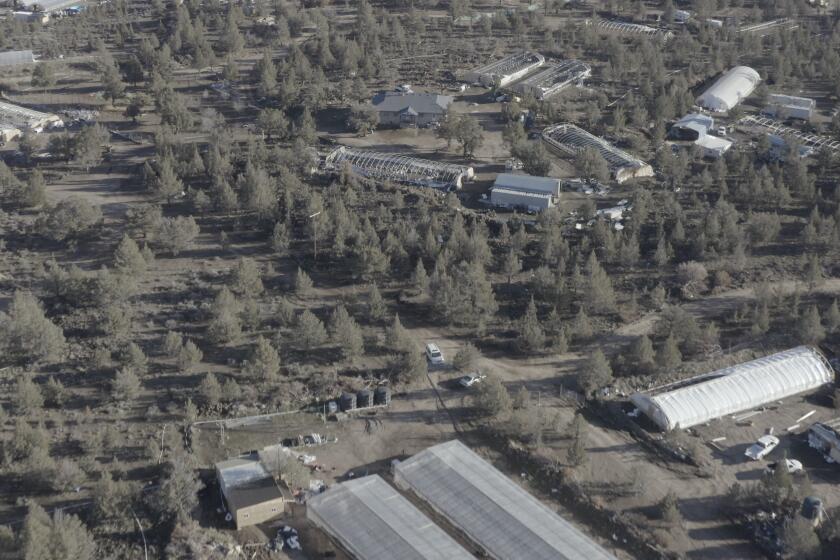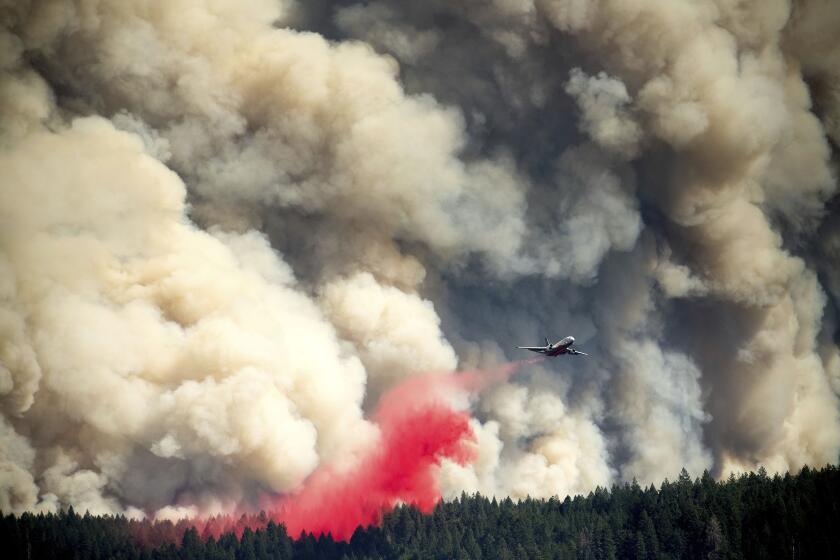Firefighters battle massive fire near Hemet from the sky at night
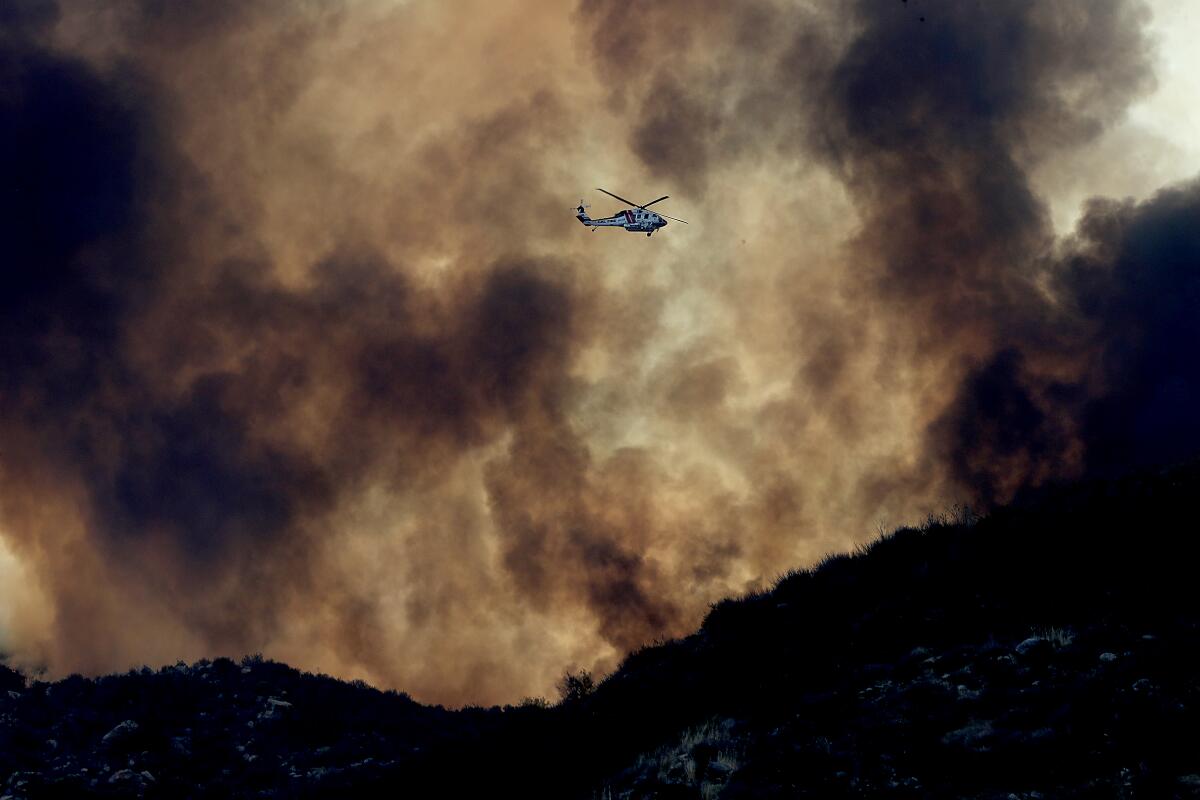
- Share via
Hemet-Ryan Airport was buzzing with activity Saturday morning as Cal Fire pilots readied to begin another long day battling the deadly Fairview fire a few miles away.
Pilots worked out to blaring heavy metal in an outdoor gym near the tarmac, swinging kettlebells and pounding out pushups in the unseasonably cool weather brought overnight by the remnants of Tropical Storm Kay.
With the Alabama-Texas football game playing on a big screen at one end of the low-slung mess hall, cooks prepared long trays of bacon-wrapped meatloaf for lunch as the last of the morning’s sausage and eggs was put away.
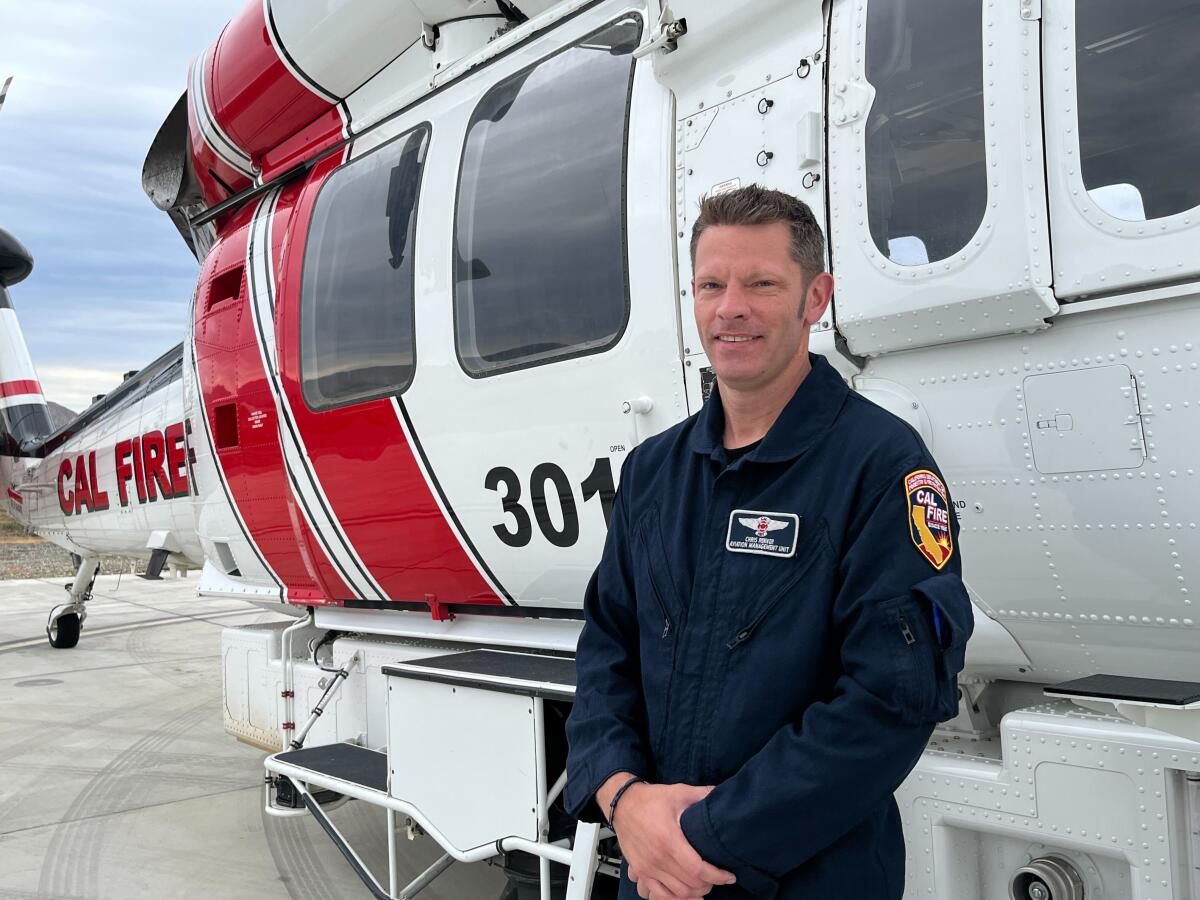
It was a rare moment of downtime for Chris Renner, a forestry fire pilot for the Aviation Management Unit of the California Department of Forestry and Fire Protection. The 40-year-old spent Wednesday and Thursday nights in the cockpit of a “Cal Hawk” — a Cal Fire-modified Blackhawk helicopter — picking up 1,000 gallons of water at a time from Diamond Valley Lake and releasing it from about 150 feet above the Fairview fire.
“The first night there was some really intense fire activity — 50-foot fire whorls,” he said. “We were trying to hit the hot spots, slow it down as much as we could. We didn’t want the fire to burn over the ground crews’ containment lines.”
Illegal cannabis farms are engulfing parts of California and exploiting farmworkers who labor in squalid, deadly conditions, a Times investigation finds.
Such water drops are a key function of any aerial firefighting operation. But the Fairview fire is one of the first handful in which Cal Fire has deployed specially trained pilots like Renner to fly at night using night-vision goggles, joining other fire departments, like Los Angeles’, that have been fighting blazes from the skies in the dark for years.
The approach allows for water and retardant drops while pilots track fires from above, which provides vital information about fire movement and activity to firefighters on the ground.
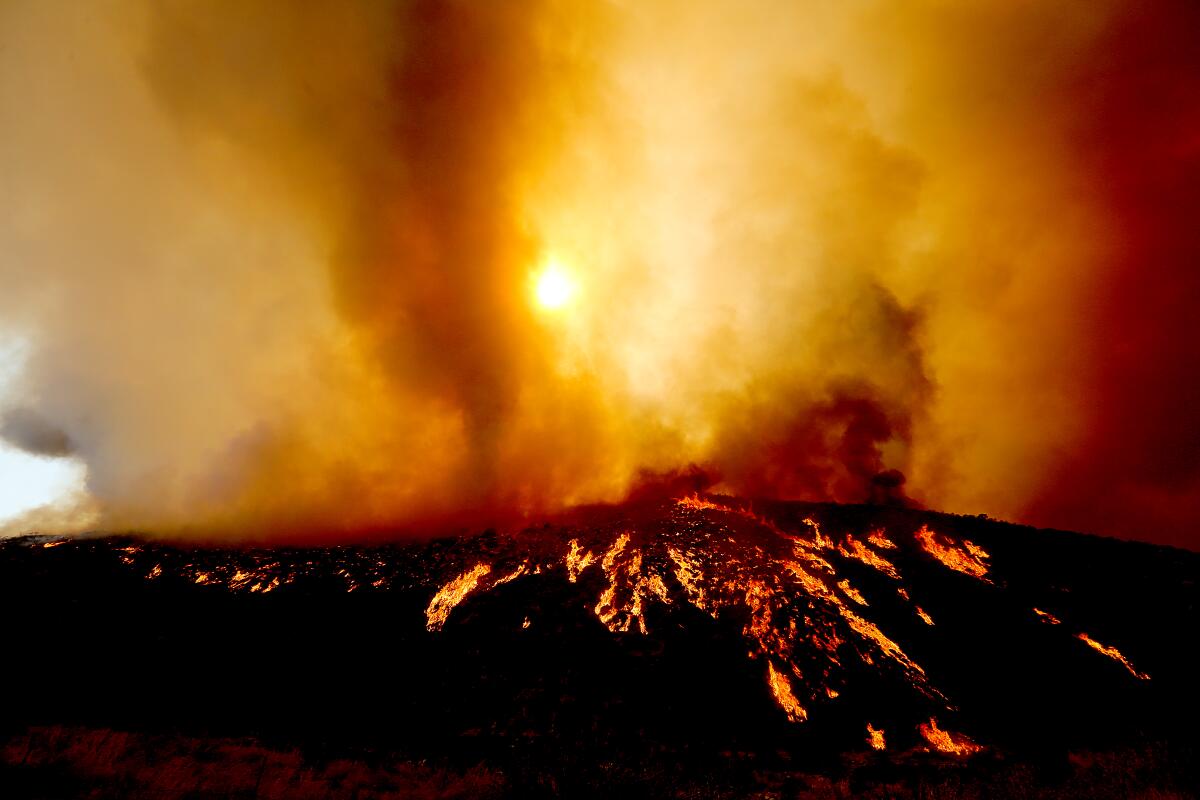
“The ability to fly at night has really increased the capability of firefighters working night shift” on the ground, Marc Peebles, a public information officer for the U.S. Forest Service, said. “So just like you see during the day, with all the spectacular water and retardant drops, they’re able to do that at night.”
The primary role of aircraft is not to put out fires but to support ground crews, said Chance Inwood, air operations branch director for Cal Fire Team 6.
Still, the night runs played a key role in suppressing the Fairview fire and coordinating resources, as when they helped keep a cluster of homes and other structures near Hemet from burning, Renner said.
“One of the houses had some bushes burning in its yard. And we — between us and other aircraft — did about four drops of water on their property,” he said. “But we weren’t able to put it out, so we got ahold of a nearby engine over the radio and they went over and were able to put it out.”
Peebles, who was working from a trailer at the Fairview fire’s incident command Saturday morning, said flying in the dark with night-vision goggles is “very, very dangerous” and only done by specially trained pilots. Still, air drops have been a key tool in the comprehensive approach to fighting the fire.
“This is a full-suppression fire. That means we go after it with everything we’ve got. We’re going to be here days, maybe weeks,” he said.
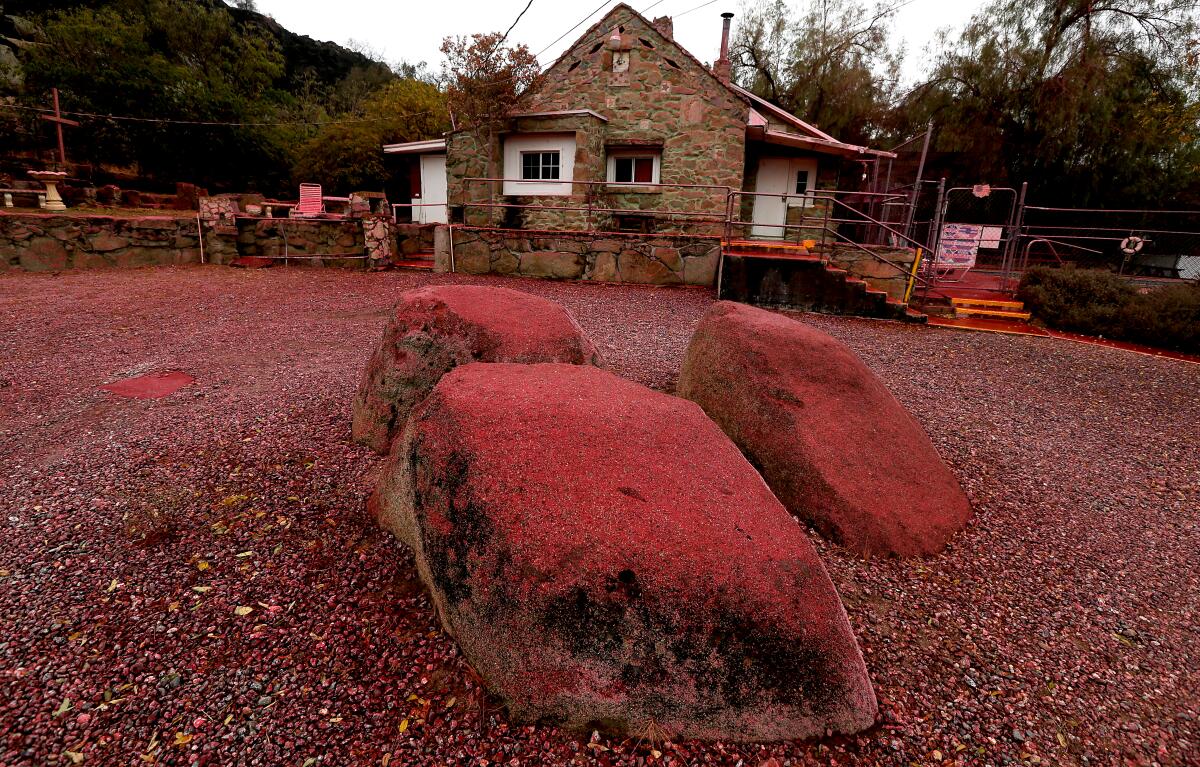
Cal Fire reported Sunday afternoon that the fire had spread to roughly 28,300 acres and was about 45 % contained. Two people were killed and at least one person was taken to the hospital with injuries, he said, adding that the injured victim is expected to survive. Thirteen buildings have been destroyed, with another four sustaining damage, he said.
He said fire officials expect the blaze to be fully extinguished by Monday. Nearly 1,200 firefighters have been deployed to the area.
John Schaures, an air tanker pilot for a contractor called Amentum that provides pilots and mechanics to Cal Fire, said that at the height of the Fairview fire he worked shifts that ran from 7:45 a.m. to dark.
He said he did 60 drops over the massive fire in Riverside County over two days. That was possible, Schaures said, because the airport, which is home to a Cal Fire base, “just happens to be close” to the Fairview fire.
“The fire’s only six miles away, so I can get about three to four drops of 1,000 gallons of retardant per hour,” he said. “It’s exciting to be up there and it’s challenging. Every drop is different.”
Schaures pulled up a photo on his cellphone that a fellow pilot had taken from an OV-10 Bronco aircraft high above the fire-affected area. The brushland near Hemet is streaked bright red by retardant, which is dyed so pilots can see where it’s already been dropped.
The pilot pointed at a few unidentifiable structures parallel to a stretch of empty road that he had helped protect from the fire’s ravages.
“I was particularly interested in these houses,” he said. “We were doing structure protection, so I was particularly worried about these.”
Record heat is fueling dangerous fires across California, pushing firefighters to the limit and creating ideal conditions for more blazes to spark and spread.
Justin McGough, day operations branch chief for Cal Fire, said firefighters used aircraft for about an hour and a half to gain control of the flames on Friday “before the high winds shut that down.”
The highest winds were recorded in the northeast part of the containment zone, in the area of Oak Cliff and White Post Turn, McGough said. The south and southwest quadrants were also “extremely wind tested,” resulting in spot fires outside the containment zone, which necessitated the rescue of several residents, he said.
Although conditions had improved, McGough said officials wouldn’t let the rainfall and increased relative humidity “lull us into complacency to think that this fire is out.”
“We’re not out of the woods here,” he said. “We’ve got a lot of open lines on the southern end of this fire and some very heavy fuels.”
He encouraged people in areas under evacuation order to leave immediately and find safety.
Cal Fire keeps several aircraft at Hemet-Ryan Airport for deployment throughout the region. But when a major conflagration like the Fairview fire breaks out, the agency and contractors fly in tankers, planes and helicopters.
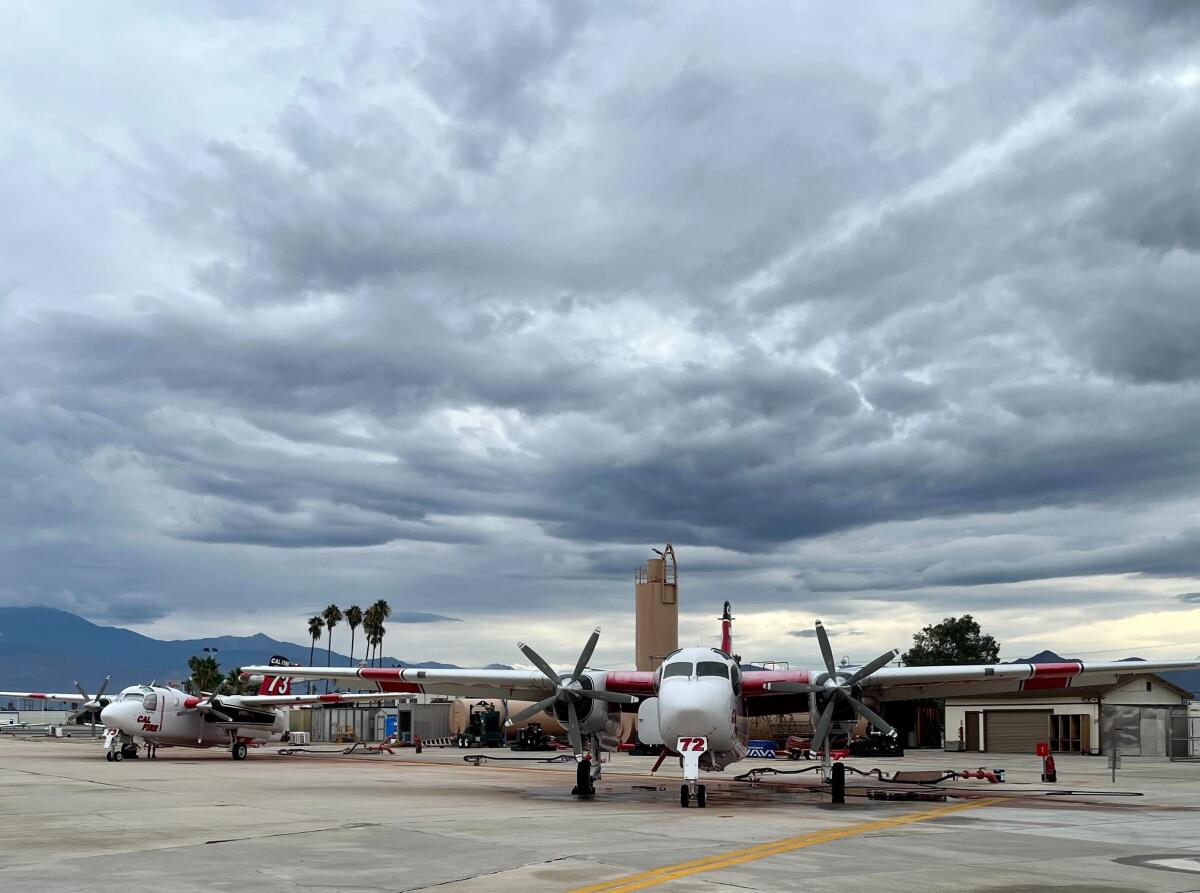
The aircraft remain in place until fire officials determine they’re no longer needed. Inwood has determined the night runs are no longer necessary and released the pilots who executed them. So Renner was headed back home to Sacramento on Saturday.
Peebles said the rain grounded air operations overnight but its effect on suppressing the fire has been invaluable as it has “modified the fire behavior quite a bit” and contributed to the swift increase in containment since Friday.
“The weather’s been our friend,” he said. “The rain came in as a slower consistent rain, as opposed to a deluge. … Had it been a deluge, we would have been worried about flash flooding and debris flows in the fire area that would have posed a hazard to firefighters. Fortunately, that didn’t materialize.”
But Cal Fire meteorologist Matt Mehle said risks remain. He said he expected wind gusts of 20 to 30 miles per hour, lower temperatures and higher humidity on Saturday.
“Concerns for firefighters on the line are going to be focused on scattered showers and possibly thunderstorms,” raising the risk of flooding, he said. He added that the area is under a flood watch through midnight. “Fortunately, winds will be much less today; they will still be out of the east and southeast.”
More to Read
Sign up for Essential California
The most important California stories and recommendations in your inbox every morning.
You may occasionally receive promotional content from the Los Angeles Times.
